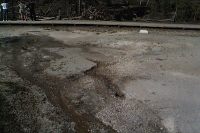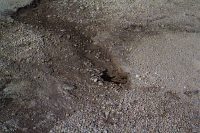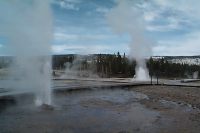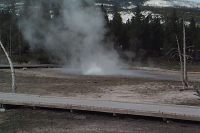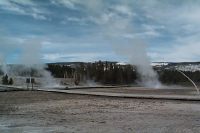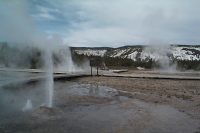Today showed a number of the ways that things can go wrong on a weekend trip, or at least how they can not be as good as they could be. Nothing catastrophic, like for last year when my old truck immediately needed repairs the day I arrived. Just a bunch of annoyances.
First, I left from home too soon, so I arrived in the park while it was still dark. I'd forgotten what nighttime driving here can be like. It's something I've never liked it, even if it's the one time of day that the roads are free of other vehicles. The odds of meeting up with a bison are just too great. To make things worse, there was thick fog almost the entire way from West Yellowstone. Doing 30mph was more than fast enough, but some stretches, like the Firehole south of the canyon until the Lower Basin, seemed to go forever.
And the bison still made their presence felt. There must have been a large herd using the road as a trail just a few hours earlier, because the lower part of my truck behind each wheel on the left side was thick with manure. I will definitely be visiting a carwash when I get home.
So I figure the best time to arrive would be just before sunrise.It will be light, but before the bison and most visitors are up and about and blocking the road. Last weekend I arrived after the ranger-in-a-box went on duty, and had to deal with both varieties of obstruction. I want to set up a nice routine that gets followed every trip, so I keep the thinking about it to a minimum. (The same goes for prepacking needed items not used at home, and making checklists for the stuff that I need to gather up.)
The weather wasn't nice either. The fog turned into gray overcast skies, which turned into precipitation. Unfortunately, it warmed up just enough so that it was rain and not snow. This continued off an on all afternoon, although it could actually be nice when the sun broke through and the wind died down With a limited amount of time, it seems a waste to be sitting and waiting to go out, but if there is nothing to wait for, there's also no point in getting soaked and chilled. This was typical weather for late spring, and one of the reasons I have usually avoided long visits this time of year. (Last year being an exception due to job commitments that worked out well.) I knew from the forecast it was going to be scattered rain. Just means in future years, springtime trips will be limited and subject to cancellation.
Then there were the petty annoyances: I broke the wire on the bike's odometer. It's horrible not knowing how far I've gone and how fast I'm going. On the other hand, I can get it fixed or replaced before the next trip, and will also figure out how to prevent it from happening again.
Perhaps for the best to get all these things out of the way. It does help set a baseline for what to expect, and I always prefer being pleasantly surprised when things go right. Having to use the rain and cold weather gear did show that I'd packed the right items And I've got another day and a half this trip, in which thngs can go either right or wrongl
.
And what about the geysers themselves? I saw another Penta, which is always nice, even if I missed the start. On my way there I finally got to see activity in those features on the other side of Sawmill's runoff at the end of the bridge. I'd seen it before, sometime in the early '90s, but that had been from the walkway just below Crested. This eruption only lasted 39 seconds, so you've really got to be there to see it. The second vent between it and the river drained, then refilled to the rim only to drop down a foot. The water also turned a milky white in all the vents. During the Penta eruption, Churn filled as the rest of the group dropped, but no eruption.
There's also a new feature over on Geyser Hill at the north of that expanse of sputs between Depression and Arrowhead. At least I've never seen it before, and didn't see it last week. I really should try to get to Geyser Hill more often,and for more than just Beehive, especially since it's an easy walk from the Lodge Cabins. There's something about not being able to bike over there that keeps me away.
Grand at least waited until I could get out there this morning. I caught the end of Rift, which was probably the reason. The next Grand was during one of the aforementioned rainstorms. I tried to catch Daisy but a wind shift meant I saw a lot of steam, and not much Daisy. Giant is going to be a great timewaster for the next few weeks. It looks so impressive with all the activity until you realize its been essentially unchanged all month.

